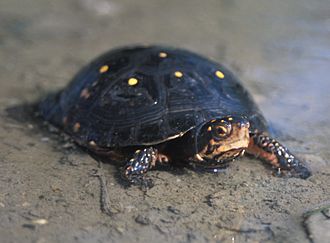Type the name of the breed you're looking for below
[wpdreams_ajaxsearchlite] Don't see the breed your're looking for? Click here and let us know!
Spotted Turtle
| Place of Origin and Range | The spotted turtle ranges from southern Maine, Quebec, and Ontario, south along the eastern US to Florida in the east and central Indiana and Ohio in the west. Disjunct populations exist in the Canadian portion of its range and also in central Illinois, central Georgia, North Carolina, South Carolina, and Indiana. |
| Description | The spotted turtle is small and has a grey to black base colour. Its upper shell (carapace) is smooth, does not have a central ridge running down the middle. It is also totally black and contains anywhere from zero to about one hundred yellow spots, which are a defining characteristic of this turtle. Although perhaps inconsequential, it has been found that the left side of the upper shell has more spots than the right. Spots can always be found on the head, neck, and limbs. The bottom shell (plastron) is yellow or orange-yellow and a black spot is present on each section |
| Morph Patterns Available | No |
| Adult Size | Can grow up to 5.5in(14cm) |
| Accommodation | A filtered aquarium with water temperature at 70-80'F(21-26'C), and a sloping ramp(driftwood, textured plastic or some other non-abrasive surface) leading from the bottom to an illuminated and warmed basking spot. Approx 80'F(27'C). |
| Lifespan | Can live 20+ years |
| Feeding / Diet | Snails, crayfish, minnows, worms,insects, and prepared foods such as pelleted trout, catfish pellets, and koi pellets. |
| Other Considerations | In Canada, the spotted turtle is federally endangered. Watch for theses health concerns carefully with your turtle. Vitamin A Deficiency: Vitamin A is an important nutrient for your turtle’s health. It is found in his diet in the form of leafy green, orange or yellow vegetables, liver, and fish. If your turtle is not getting enough Vitamin A, he can suffer serious health problems. Always check to make sure that your turtle does not have swollen eyelids, as this is the main sign of a Vitamin A deficiency. Also, check for weight loss, nasal discharge and infected skin. Any of these symptoms could point to a deficiency. If you think your turtle may not be getting enough Vitamin A, you should take him to the veterinarian to get a firm diagnosis. Shell Problems: Your turtle’s shell is very important to his overall health. There are many potential problems that could occur, so you should be on the lookout at all times. Respiratory Disease: Respiratory infections have symptoms similar to vitamin A deficiency, including swollen eyelids and runny nose, so you should take your turtle to the veterinarian to get a proper diagnosis if you suspect either. More serious infections will be characterized by breathing through the mouth, mucus in the mouth, and wheezing. Always make sure your turtle’s environment has the proper amount of humidity, as this will help prevent respiratory problems. |



